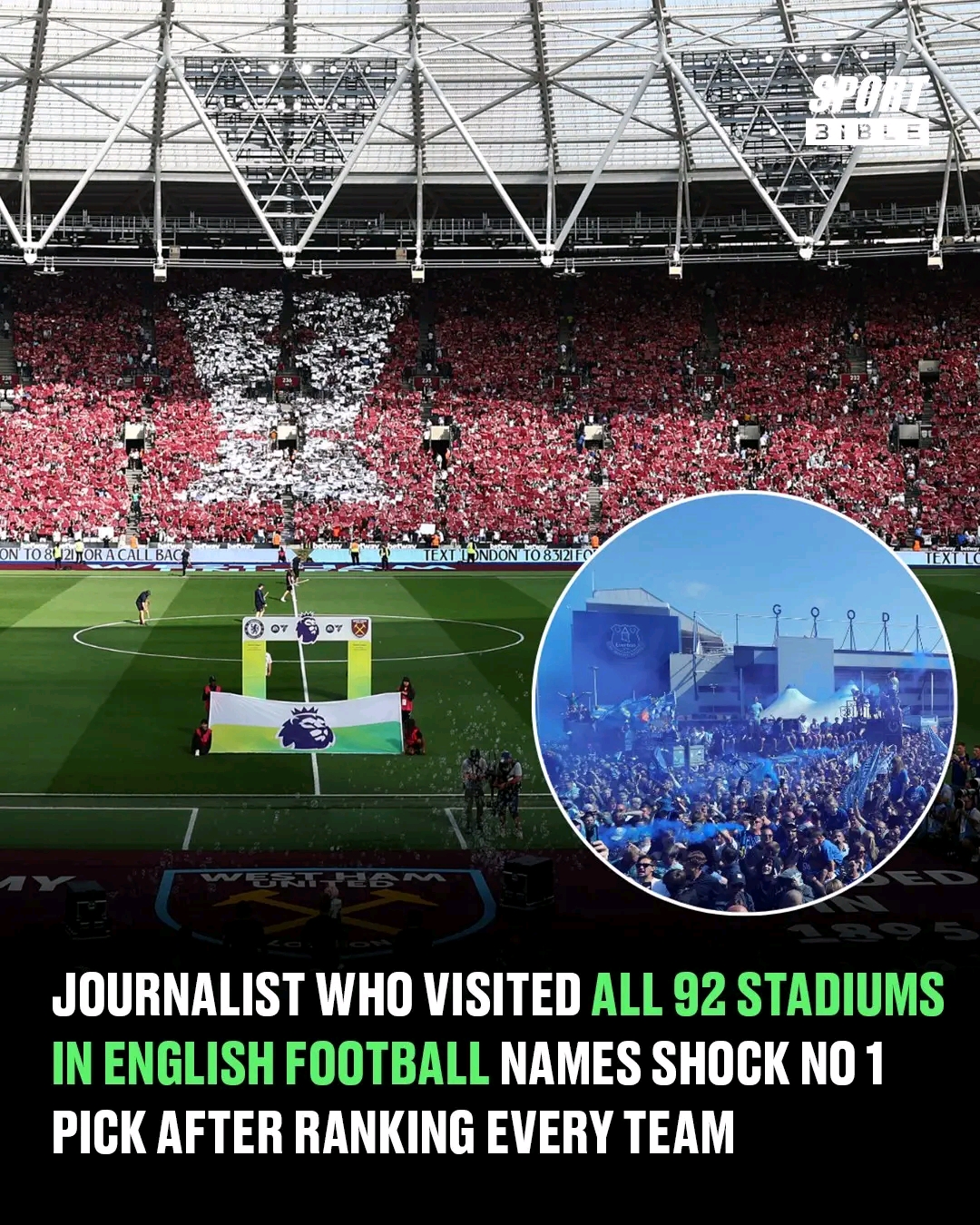Journalist ranks the 92 Football League stadiums after visiting them all in one season with six Premier League grounds in top 10

In an extraordinary feat of dedication and endurance, journalist Daniel Storey of the i Paper embarked on one of the most ambitious projects in football journalism: visiting all 92 stadiums across England’s top four football divisions in a single season. His remarkable journey, dubbed “Doing the 92,” culminated with a visit to Nottingham Forest’s City Ground on the final day of the Premier League campaign, marking the completion of a quest that would see him rank every single ground from worst to first.
The concept of stadium rankings has always been a contentious topic among football supporters, with passionate fans invariably believing their home ground deserves recognition near the summit of any list. Storey’s comprehensive assessment was no different, sparking debate and discussion across the football community as supporters scrutinized his choices and questioned his methodology.
Storey’s list began with immediate controversy, placing West Ham United’s London Stadium in a lowly 91st position out of 92. His scathing assessment of the former Olympic Stadium was particularly harsh, describing it as a venue that “doesn’t feel like a football stadium.” This criticism reflects a common sentiment among football purists who argue that the ground, originally designed for athletics during the 2012 London Olympics, lacks the intimate atmosphere and character that defines traditional football venues.
The transformation of the London Stadium from Olympic venue to football ground has been fraught with challenges since West Ham’s move from their beloved Upton Park in 2016. The athletics track that remains around the pitch creates a significant distance between supporters and the action, fundamentally altering the matchday experience that fans had grown accustomed to at their previous home. Storey’s ranking reflects these ongoing issues with the venue’s suitability for football.
Preston North End’s Deepdale, widely regarded as English football’s oldest stadium still hosting matches, found itself in a surprisingly modest 51st position. This placement speaks to the complex balance between historical significance and modern stadium experience that Storey had to navigate throughout his rankings. While Deepdale carries immense historical weight as the birthplace of professional football, its current facilities and matchday experience evidently fell short of the standards set by other venues in Storey’s comprehensive assessment.
The positioning of such a historically significant venue highlights one of the central tensions in modern football stadium evaluation: the balance between heritage and contemporary amenities. Deepdale’s relatively low ranking suggests that historical importance alone wasn’t sufficient to secure a higher position in Storey’s carefully considered list.
Perhaps one of the most telling aspects of Storey’s rankings was the placement of Manchester United’s Old Trafford at 32nd position. For a stadium often referred to as the “Theatre of Dreams” and home to one of the world’s most successful football clubs, this ranking represents a significant fall from grace.
Storey’s assessment was particularly damning in its criticism of the Glazer family’s stewardship of the iconic venue. He noted that “it is desperately sad that the slow strangulation of Manchester United by the Glazer family through their leveraged buyout and the continued accumulation of debt has led to the facilities at Old Trafford being degraded over time.”
This critique reflects broader concerns among Manchester United supporters about the state of their stadium infrastructure. Once considered one of the finest venues in world football, Old Trafford has suffered from what many perceive as years of underinvestment. Issues with leaking roofs, outdated facilities, and general maintenance have become increasingly apparent, leading to calls for significant renovation or even complete reconstruction.
The positioning of Old Trafford at 32nd, sandwiched between Sunderland’s Stadium of Light in 33rd and Wrexham’s Racecourse Ground in 31st, serves as a stark reminder of how even the most prestigious venues can decline without proper investment and care.
## The Wrexham Renaissance
Speaking of Wrexham’s Racecourse Ground, Storey’s praise for the Welsh club’s venue reflects the remarkable transformation that has occurred under the ownership of Hollywood actors Ryan Reynolds and Rob McElhenney. The journalist described the owners as “having built something very special,” acknowledging the significant investment and attention to detail that has elevated the matchday experience at one of the world’s oldest football stadiums.
The Racecourse Ground’s 31st position represents not just the physical improvements made to the venue, but also the atmosphere and sense of occasion that Reynolds and McElhenney have helped cultivate. Their commitment to the club and its facilities has created a template for how thoughtful ownership can transform even modest venues into special places for football.
## Premier League Presence in the Elite
Six Premier League clubs managed to secure positions in Storey’s top 10, demonstrating that while top-flight status doesn’t guarantee stadium excellence, the resources available to Premier League clubs often translate into superior facilities and matchday experiences.
Leeds United’s Elland Road claimed the final spot in the top 10, positioned at 10th place. The Yorkshire club’s stadium, with its storied history and passionate support, represents the kind of traditional football venue that resonates with purists while maintaining modern standards that enhance the supporter experience.
The inclusion of six Premier League venues in the top tier reflects the significant investment that has been made in stadium infrastructure across England’s top division in recent decades. From major renovations to complete reconstructions, Premier League clubs have generally prioritized the stadium experience as a crucial component of their commercial and sporting success.
## The Podium Places
The top three positions in Storey’s rankings tell a fascinating story about what makes a truly exceptional football venue in the modern era.
### Third Place: Nottingham Forest’s City Ground
The City Ground’s inclusion in the top three carries particular significance, as Storey openly acknowledged his support for Nottingham Forest. However, his placement of his own club’s ground at third position speaks to both his journalistic integrity and the genuine quality of the venue.
Storey’s description of the view from the north towards Trent Bridge as “unbeatable” highlights one of the City Ground’s most distinctive features. The stadium’s location along the River Trent creates a unique setting that few football venues can match. The proximity to Trent Bridge cricket ground and the historic city center adds layers of character that extend beyond the stadium walls.
The City Ground’s positioning within Nottingham’s sporting quarter is remarkable, with three major sports venues – the City Ground, Notts County’s Meadow Lane, and Nottinghamshire’s Trent Bridge cricket ground – all located within 200 meters of each other. This concentration of sporting heritage creates an atmosphere and sense of place that is genuinely unique in English football.
### Second Place: AFC Wimbledon’s Cherry Red Records Stadium
The runner-up position went to AFC Wimbledon’s Cherry Red Records Stadium, a choice that speaks to the emotional power of football venues and the importance of connection to place and community.
Built just 200 yards from the site of Wimbledon FC’s former Plough Lane ground, the Cherry Red Records Stadium represents one of football’s most remarkable homecoming stories. AFC Wimbledon’s journey from non-league football back to their spiritual home carries enormous emotional weight, and Storey’s high ranking acknowledges how this narrative enhances the stadium experience.
The venue itself may not possess the grandeur of some Premier League stadiums, but its significance to the community and the passionate support it generates creates an atmosphere that transcends pure architectural merit. This ranking demonstrates Storey’s appreciation for the intangible qualities that make football venues special: history, community connection, and the emotional resonance that comes from understanding a club’s journey.
### First Place: Grimsby Town’s Blundell Park
The top spot in Storey’s comprehensive ranking went to League Two side Grimsby Town and their home ground, Blundell Park. This choice was perhaps the most surprising of all, elevating a fourth-tier venue above some of the most famous stadiums in world football.
Storey’s explanation for this choice reveals his appreciation for the unique character that sets certain venues apart: “You can sit and watch a football match and see tankers slowly drifting past your eye line – in what way isn’t that perfect?”
Blundell Park’s location near the Humber Estuary creates a matchday experience unlike any other in English football. The sight of ships and tankers moving slowly along the waterway provides a constant reminder of Grimsby’s maritime heritage and creates a backdrop that is both distinctive and atmospheric.
This ranking choice reflects a broader philosophy about what makes a great football venue. Rather than simply rewarding size, modernity, or prestige, Storey’s number one choice celebrates uniqueness, character, and the kind of distinctive features that create lasting memories for visitors.
## The Methodology Behind the Madness
Throughout his season-long journey, Storey didn’t merely visit each stadium as a passive observer. His “Doing the 92” series included detailed long-read pieces about each of the 92 clubs, providing context and insight that went far beyond simple stadium assessment. This comprehensive approach ensured that his rankings were informed by a deep understanding of each club’s history, community connection, and unique characteristics.
The methodology appears to have balanced multiple factors: architectural merit, atmosphere, historical significance, location, facilities, and that indefinable quality of character that separates memorable venues from merely functional ones. This holistic approach explains why some traditionally prestigious venues found themselves ranked lower than might be expected, while smaller, more characterful grounds earned recognition for their unique qualities.
## The Broader Impact and Discussion
Storey’s comprehensive ranking system has sparked extensive debate within the football community, with supporters defending their home grounds and questioning various placements throughout the list. This reaction demonstrates the deep emotional connection that exists between fans and their stadiums, and the highly subjective nature of what makes a venue special.
The rankings also serve as a snapshot of English football infrastructure at a particular moment in time. They highlight the ongoing investment in some venues, the decline of others, and the various challenges facing clubs across all levels of the football pyramid when it comes to maintaining and improving their facilities.
For clubs ranked highly, the recognition provides validation for their investment in stadium infrastructure and the matchday experience. For those ranked lower, it may serve as motivation for improvement or, in some cases, honest acknowledgment of areas that need attention.
## Lessons for Stadium Development
The rankings offer valuable insights for clubs, architects, and planners involved in stadium development. The success of unique venues like Blundell Park and the Cherry Red Records Stadium suggests that character and connection to place can be more valuable than pure scale or luxury amenities.
Similarly, the relatively low ranking of venues like the London Stadium serves as a cautionary tale about the challenges of adapting multi-purpose venues for football use. The importance of atmosphere, sightlines, and the relationship between supporters and the pitch cannot be underestimated in creating successful football venues.
## Conclusion: The Subjectivity of Sporting Spaces
Daniel Storey’s remarkable journey through all 92 stadiums in English football’s top four divisions represents an extraordinary commitment to understanding the diverse landscape of football venues across the country. His rankings, controversial though they may be, provide a unique perspective on what makes stadiums special and memorable.
The elevation of Grimsby Town’s Blundell Park to the top position serves as a powerful reminder that greatness in stadium terms isn’t necessarily about size, prestige, or modern amenities. Sometimes, it’s about those unique characteristics that create unforgettable experiences and lasting memories.
Whether supporters agree with Storey’s specific rankings or not, his comprehensive assessment has succeeded in generating discussion about the importance of stadium character, the value of investment in football infrastructure, and the complex relationship between venues and the communities they serve. In completing his ambitious project, Storey has created not just a ranking system, but a comprehensive portrait of English football’s diverse architectural and cultural landscape.
The debate surrounding his choices will likely continue, but that’s perhaps the point. Football stadiums are deeply personal spaces for supporters, places where memories are made and emotions run high. Any attempt to rank them objectively is bound to be subjective, influenced by personal experience, individual preferences, and the countless intangible factors that make each venue unique.
Storey’s “Doing the 92” represents a celebration of this diversity, acknowledging that excellence in stadium terms can take many different forms, from the maritime atmosphere of Blundell Park to the emotional homecoming of AFC Wimbledon’s return to Plough Lane. In a world increasingly dominated by homogenized sporting experiences, such recognition of character and uniqueness feels both valuable and necessary.














